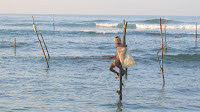Chairman Award
 When the idea of taking an assignment in
When the idea of taking an assignment in
Unlike many company awards that come with a firm  handshake and expressions of gratitude, this award, which is bestowed on only one of BearingPoint’s 18,000 employees, comes with a check for $25,000 (minus taxes, of course!). Additionally, Jay and Helen were invited to the company’s annual meeting of Managing Directors in
handshake and expressions of gratitude, this award, which is bestowed on only one of BearingPoint’s 18,000 employees, comes with a check for $25,000 (minus taxes, of course!). Additionally, Jay and Helen were invited to the company’s annual meeting of Managing Directors in
Being recognized for one’s work is always embracing. Our story in
 Airlines tickets to come the 9,000 mile back home were booked and
Airlines tickets to come the 9,000 mile back home were booked and
 After a rollicking ride at the Revenge of the Mummy, some toe tapping to the Blues Brothers, a monster mash-like Beetlejuice revue, a real hamburger at a fifties café, a spectacular show with Poseidon and a host of other adventurers, we were back at the JW Marriott by 2:30 pm for the award presentation.
After a rollicking ride at the Revenge of the Mummy, some toe tapping to the Blues Brothers, a monster mash-like Beetlejuice revue, a real hamburger at a fifties café, a spectacular show with Poseidon and a host of other adventurers, we were back at the JW Marriott by 2:30 pm for the award presentation.
 During the brief ceremony, Chairman McGeary recognized both Jay and the contributions Helen had made. Due to time constraints Jay was unable to give his acceptance speech. If he had, he would have concluded his list of thanks to the many, many others who made the award possible with:
During the brief ceremony, Chairman McGeary recognized both Jay and the contributions Helen had made. Due to time constraints Jay was unable to give his acceptance speech. If he had, he would have concluded his list of thanks to the many, many others who made the award possible with:
“Finally, I want to thank my lovely wife, Helen. She left her job and ventured forth. Through everything she has been helpful, encouraging and supportive as we shared our challenges and affections for our new home in
Helen. She left her job and ventured forth. Through everything she has been helpful, encouraging and supportive as we shared our challenges and affections for our new home in
























































